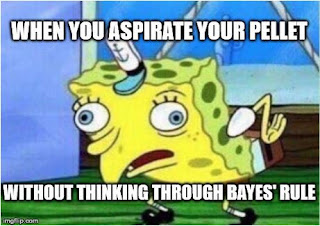Negative results are not necessarily bad results
So you get your data back, you crunch the numbers, and nothing significant shows up. There's no time to repeat an experiment or try anything new. Every researcher's worst nightmare, right?
You've never read a paper that says, "We found nothing." But now you have to write one.
My partner and I struggled a lot with coming up with things to say about our very limited data. We had generated figures throughout the module, but all the data either wasn't significant, or didn't seem directly related to ligand binding. So on the Saturday before the deadline, my partner and I sat down at Josephine's office hours for 7 hours, ate half a coffee cake, and tried to piece it all together.
Writing the captions and body text for each figure individually was well and good. May I recommend this tried and true formula:
You've never read a paper that says, "We found nothing." But now you have to write one.
My partner and I struggled a lot with coming up with things to say about our very limited data. We had generated figures throughout the module, but all the data either wasn't significant, or didn't seem directly related to ligand binding. So on the Saturday before the deadline, my partner and I sat down at Josephine's office hours for 7 hours, ate half a coffee cake, and tried to piece it all together.
Writing the captions and body text for each figure individually was well and good. May I recommend this tried and true formula:
- Start off with any relevant methods
- "We used differential scanning fluorimetry to measure the melting temperature"
- Explain what trends are on the figure
- "the melting curve for the protein peaked at a higher temperature with rapamycin than the control"
- briefly mention that none of it is significant
- interpret what the trend means and move towards an explanation
- "the melting temperature increased because rapamycin stabilized the protein"
But when it came to writing a story that would incorporate all these data into a coherent abstract and title, I was lost. We wrote and rewrote, trying each time to make an exciting conclusion when there was no conclusion to be drawn.
But finally, I came to terms with my data. I asked my UROP supervisor whether he had ever wound up with unfulfilling data, and he taught me the difference between a bad result and a negative result. Bad results were invalid and poorly gotten, borne of experimental error. Negative results, on the other hand, were valid, and they were still results, and you should report them candidly and without shame. Now, I admit my results were probably both negative and bad, given my hideous error bars. But I understood that I needed to be upfront that no conclusions could be drawn regarding the effects of these ligands, and that in itself was a conclusion. I had tried my best to see what happened when these ligands bound to our protein, and I didn't see anything, which is a perfectly fine thing to see.
We had found our goal: to characterize the binding interactions between these new ligands and our protein. Our conclusion: The binding interactions in the conditions studied didn't cause any significant change in protein function or stability. Why? Is the ligand not bound? Did we use the wrong concentrations? Does it use a wacky revolutionary mechanism to imbue our protein with magic powers that we can't detect? That's up to further study.
But finally, I came to terms with my data. I asked my UROP supervisor whether he had ever wound up with unfulfilling data, and he taught me the difference between a bad result and a negative result. Bad results were invalid and poorly gotten, borne of experimental error. Negative results, on the other hand, were valid, and they were still results, and you should report them candidly and without shame. Now, I admit my results were probably both negative and bad, given my hideous error bars. But I understood that I needed to be upfront that no conclusions could be drawn regarding the effects of these ligands, and that in itself was a conclusion. I had tried my best to see what happened when these ligands bound to our protein, and I didn't see anything, which is a perfectly fine thing to see.
We had found our goal: to characterize the binding interactions between these new ligands and our protein. Our conclusion: The binding interactions in the conditions studied didn't cause any significant change in protein function or stability. Why? Is the ligand not bound? Did we use the wrong concentrations? Does it use a wacky revolutionary mechanism to imbue our protein with magic powers that we can't detect? That's up to further study.
Happy researching,


Comments
Post a Comment